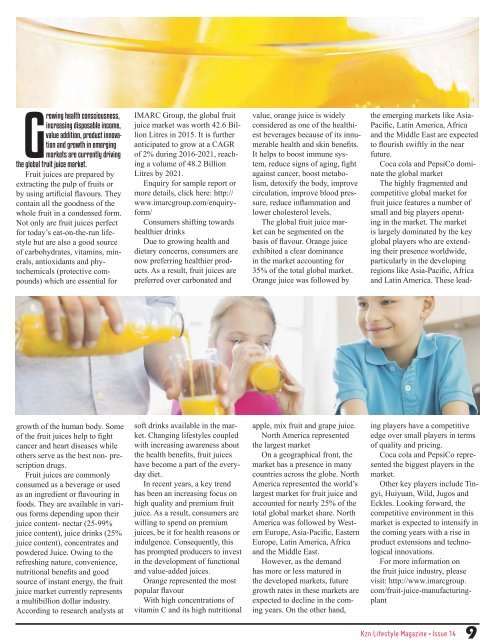You also want an ePaper? Increase the reach of your titles
YUMPU automatically turns print PDFs into web optimized ePapers that Google loves.
Growing health consciousness,<br />
increasing disposable income,<br />
value addition, product innovation<br />
and growth in emerging<br />
markets are currently driving<br />
the global fruit juice market.<br />
Fruit juices are prepared by<br />
extracting the pulp of fruits or<br />
by using artificial flavours. They<br />
contain all the goodness of the<br />
whole fruit in a condensed form.<br />
Not only are fruit juices perfect<br />
for today’s eat-on-the-run lifestyle<br />
but are also a good source<br />
of carbohydrates, vitamins, minerals,<br />
antioxidants and phytochemicals<br />
(protective compounds)<br />
which are essential for<br />
IMARC Group, the global fruit<br />
juice market was worth 42.6 Billion<br />
Litres in 2015. It is further<br />
anticipated to grow at a CAGR<br />
of 2% during 2016-2021, reaching<br />
a volume of 48.2 Billion<br />
Litres by 2021.<br />
Enquiry for sample report or<br />
more details, click here: http://<br />
www.imarcgroup.com/enquiryform/<br />
Consumers shifting towards<br />
healthier drinks<br />
Due to growing health and<br />
dietary concerns, consumers are<br />
now preferring healthier products.<br />
As a result, fruit juices are<br />
preferred over carbonated and<br />
value, orange juice is widely<br />
considered as one of the healthiest<br />
beverages because of its innumerable<br />
health and skin benefits.<br />
It helps to boost immune system,<br />
reduce signs of aging, fight<br />
against cancer, boost metabolism,<br />
detoxify the body, improve<br />
circulation, improve blood pressure,<br />
reduce inflammation and<br />
lower cholesterol levels.<br />
The global fruit juice market<br />
can be segmented on the<br />
basis of flavour. Orange juice<br />
exhibited a clear dominance<br />
in the market accounting for<br />
35% of the total global market.<br />
Orange juice was followed by<br />
the emerging markets like Asia-<br />
Pacific, Latin America, Africa<br />
and the Middle East are expected<br />
to flourish swiftly in the near<br />
future.<br />
Coca cola and PepsiCo dominate<br />
the global market<br />
The highly fragmented and<br />
competitive global market for<br />
fruit juice features a number of<br />
small and big players operating<br />
in the market. The market<br />
is largely dominated by the key<br />
global players who are extending<br />
their presence worldwide,<br />
particularly in the developing<br />
regions like Asia-Pacific, Africa<br />
and Latin America. These lead-<br />
growth of the human body. Some<br />
of the fruit juices help to fight<br />
cancer and heart diseases while<br />
others serve as the best non- prescription<br />
drugs.<br />
Fruit juices are commonly<br />
consumed as a beverage or used<br />
as an ingredient or flavouring in<br />
foods. They are available in various<br />
forms depending upon their<br />
juice content- nectar (25-99%<br />
juice content), juice drinks (25%<br />
juice content), concentrates and<br />
powdered Juice. Owing to the<br />
refreshing nature, convenience,<br />
nutritional benefits and good<br />
source of instant energy, the fruit<br />
juice market currently represents<br />
a multibillion dollar industry.<br />
According to research analysts at<br />
soft drinks available in the market.<br />
Changing lifestyles coupled<br />
with increasing awareness about<br />
the health benefits, fruit juices<br />
have become a part of the everyday<br />
diet.<br />
In recent years, a key trend<br />
has been an increasing focus on<br />
high quality and premium fruit<br />
juice. As a result, consumers are<br />
willing to spend on premium<br />
juices, be it for health reasons or<br />
indulgence. Consequently, this<br />
has prompted producers to invest<br />
in the development of functional<br />
and value-added juices.<br />
Orange represented the most<br />
popular flavour<br />
With high concentrations of<br />
vitamin C and its high nutritional<br />
apple, mix fruit and grape juice.<br />
North America represented<br />
the largest market<br />
On a geographical front, the<br />
market has a presence in many<br />
countries across the globe. North<br />
America represented the world’s<br />
largest market for fruit juice and<br />
accounted for nearly 25% of the<br />
total global market share. North<br />
America was followed by Western<br />
Europe, Asia-Pacific, Eastern<br />
Europe, Latin America, Africa<br />
and the Middle East.<br />
However, as the demand<br />
has more or less matured in<br />
the developed markets, future<br />
growth rates in these markets are<br />
expected to decline in the coming<br />
years. On the other hand,<br />
ing players have a competitive<br />
edge over small players in terms<br />
of quality and pricing.<br />
Coca cola and PepsiCo represented<br />
the biggest players in the<br />
market.<br />
Other key players include Tingyi,<br />
Huiyuan, Wild, Jugos and<br />
Eckles. Looking forward, the<br />
competitive environment in this<br />
market is expected to intensify in<br />
the coming years with a rise in<br />
product extensions and technological<br />
innovations.<br />
For more information on<br />
the fruit juice industry, please<br />
visit: http://www.imarcgroup.<br />
com/fruit-juice-manufacturingplant<br />
Kzn Lifestyle Magazine • Issue 14<br />
9


















